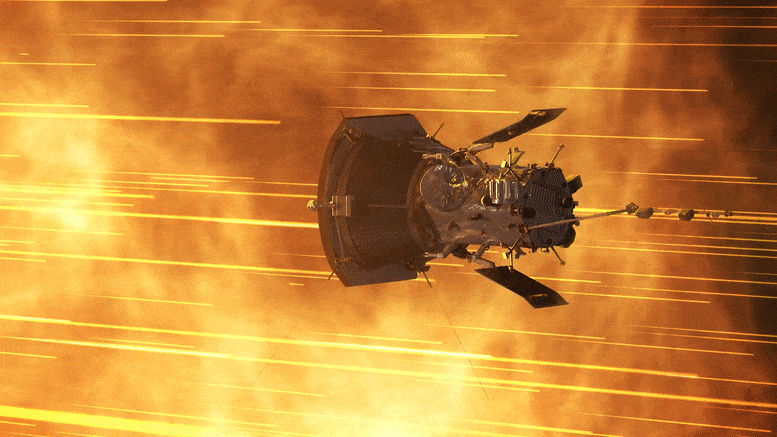In a remarkable celestial endeavor, the Parker Solar Probe recently completed its 17th close encounter with the Sun, venturing within a mere 7.26 million kilometers of the sun’s photosphere. This mission, extending its investigative pursuits until 2025, is dedicated to the unraveling of enigmatic solar phenomena and the provision of pivotal insights into the workings of our radiant star.
The Parker Solar Probe, resembling an indefatigable cosmic voyager, executed its latest close approach on September 27th, positioning itself a mere 7.26 million kilometers (approximately 4.51 million miles) above the sun’s “surface” layer, commonly referred to as the photosphere. This achievement, however, represents just one in a series of remarkable milestones that this probe has achieved.
During its 13th approach to the Sun on September 5, 2022, the Parker Solar Probe achieved an unprecedented feat as the first spacecraft to traverse the tempestuous path of a coronal mass ejection (CME), surviving the ordeal and emerging with invaluable data. This accomplishment was notably facilitated by a gravity-assist flyby of Venus in late August, propelling the Parker Solar Probe at an astonishing speed of 635,266 kilometers per hour (394,735 miles per hour).
Both the recent close encounter and the audacious CME encounter constitute only a fraction of the mission’s extensive agenda, anticipated to continue its comprehensive investigation of solar dynamics and the surrounding solar environment until mid-2025. Noteworthy is the probe’s robustness, operating under extreme conditions with temperatures reaching up to 1400 degrees Celsius, yet maintaining a near-normal room-temperature environment for its essential instruments, shielded from the intense solar environment.
The primary mission objective of the Parker Solar Probe is to offer insights into some of the most perplexing aspects of the Sun’s behavior. Central to this inquiry is the examination of the solar corona, aiming to elucidate the mechanisms responsible for its elevated temperatures. Furthermore, researchers aspire to comprehend the acceleration processes governing the solar wind as it emanates from the Sun. Given the predominantly plasma nature of the Sun, a comprehensive understanding of its structural composition and the influential magnetic fields governing plasma flow is sought. Finally, the mission encompasses the study of energetic particles originating from the Sun and the determination of their transport mechanisms.
Coronal mass ejections, as observed from Earth, manifest as potent solar events, expelling vast quantities of plasma into space at speeds ranging from 100 to 3,000 kilometers per second. While not all CMEs directly impact Earth, when they do, they can perturb our planet’s magnetic field, leading to diverse consequences such as the awe-inspiring aurora borealis displays or disruptions to critical communication and electrical infrastructure.
Solar physicists harbor a long-standing aspiration to forecast these formidable solar storms, necessitating a profound understanding of the forces propelling CMEs and the acceleration mechanisms responsible for the high-speed charged particles within these eruptions. The Parker Solar Probe’s encounter with a CME on September 5, 2022, while on the far side of the Sun, enabled the capture of crucial data concerning the shock wave’s velocity and density, fortunately without any adverse effects on Earth. This event marked an extraordinary proximity to the Sun for CME observation.
In summary, the Parker Solar Probe, safeguarded by its heat shield, radiators, and thermal protection system, continues its steadfast pursuit of solar revelations. As it embarks on successive orbits around the Sun throughout 2023 and 2024, including a final Venus flyby in late 2024, it will conclude its mission with 24 perihelion passages by 2025. The wealth of data it has and will continue to provide promises to illuminate hitherto obscured facets of the solar wind and the underlying processes propelling it throughout the solar system. This remarkable endeavor stands as a testament to humanity’s commitment to understanding the celestial forces that shape our solar neighborhood. Adapted from an article originally published on Universe Today.
Table of Contents
Frequently Asked Questions (FAQs) about solar probe mission
What is the Parker Solar Probe’s primary mission?
The primary mission of the Parker Solar Probe is to study and unravel the mysteries of the Sun, particularly focusing on understanding the solar corona’s elevated temperatures and the acceleration of the solar wind as it emanates from the Sun.
How close did the Parker Solar Probe come to the Sun during its 17th approach?
During its 17th close approach, the Parker Solar Probe came within a mere 7.26 million kilometers (approximately 4.51 million miles) of the sun’s photosphere.
What significant achievement did the Parker Solar Probe accomplish during its 13th approach to the Sun?
During its 13th approach, the Parker Solar Probe became the first-ever spacecraft to traverse a coronal mass ejection (CME), a remarkable feat in the field of space exploration.
How fast was the Parker Solar Probe moving during its recent close approach to the Sun?
During its most recent close approach, the Parker Solar Probe was moving at an astounding speed of 635,266 kilometers per hour (394,735 miles per hour).
What protective measures are in place to safeguard the Parker Solar Probe during its missions?
The Parker Solar Probe is equipped with a heat shield, radiators, and a thermal protection system to safeguard its instruments from the extreme conditions of its proximity to the Sun.
How long will the Parker Solar Probe’s mission continue?
The mission of the Parker Solar Probe is scheduled to continue its investigations of the Sun and its surroundings until mid-2025, with planned close orbits around the Sun and a final Venus flyby in late 2024.
More about solar probe mission
- Parker Solar Probe Mission Overview: Detailed information about the Parker Solar Probe mission from NASA’s official website.
- Universe Today Article: The original article from Universe Today that provides insights into the Parker Solar Probe’s achievements and mission.
- Solar and Heliospheric Observatory (SOHO): Information about SOHO, a mission mentioned in the article, which studies the Sun and solar wind.
- Johns Hopkins Applied Physics Laboratory (APL): The organization responsible for building and managing the Parker Solar Probe, with insights into their role in the mission.


